Great dodecahemicosahedron
In geometry, the great dodecahemicosahedron (or small dodecahemiicosahedron) is a nonconvex uniform polyhedron, indexed as U65. It has 22 faces (12 pentagons and 10 hexagons), 60 edges, and 30 vertices.[1] Its vertex figure is a crossed quadrilateral.
| Great dodecahemicosahedron | |
|---|---|
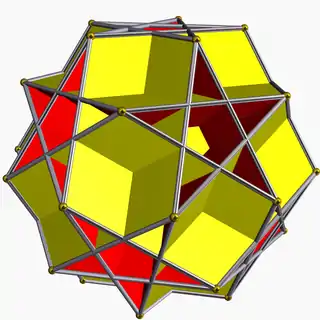 | |
| Type | Uniform star polyhedron |
| Elements | F = 22, E = 60 V = 30 (χ = −8) |
| Faces by sides | 12{5}+10{6} |
| Wythoff symbol | 3 (double covering) |
| Symmetry group | Ih, [5,3], *532 |
| Index references | U65, C81, W102 |
| Dual polyhedron | Great dodecahemicosacron |
| Vertex figure |  5.6.5/4.6 |
| Bowers acronym | Gidhei |
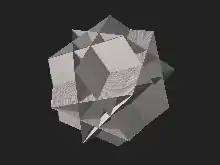
It is a hemipolyhedron with ten hexagonal faces passing through the model center.
Related polyhedra
Its convex hull is the icosidodecahedron. It also shares its edge arrangement with the dodecadodecahedron (having the pentagonal faces in common), and with the small dodecahemicosahedron (having the hexagonal faces in common).
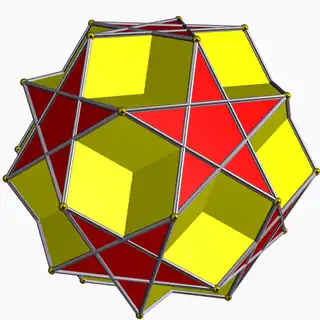 Dodecadodecahedron |
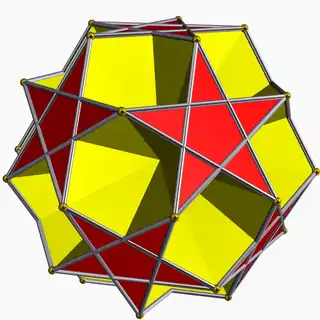 Small dodecahemicosahedron |
 Great dodecahemicosahedron |
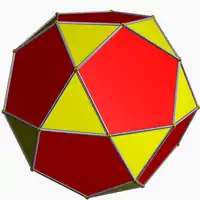 Icosidodecahedron (convex hull) |
Great dodecahemicosacron
| Great dodecahemicosacron | |
|---|---|
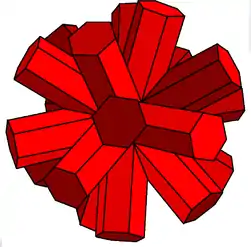 | |
| Type | Star polyhedron |
| Face | — |
| Elements | F = 30, E = 60 V = 22 (χ = −8) |
| Symmetry group | Ih, [5,3], *532 |
| Index references | DU65 |
| dual polyhedron | Great dodecahemicosahedron |
The great dodecahemicosacron is the dual of the great dodecahemicosahedron, and is one of nine dual hemipolyhedra. It appears visually indistinct from the small dodecahemicosacron.
Since the hemipolyhedra have faces passing through the center, the dual figures have corresponding vertices at infinity; properly, on the real projective plane at infinity.[2] In Magnus Wenninger's Dual Models, they are represented with intersecting prisms, each extending in both directions to the same vertex at infinity, in order to maintain symmetry. In practice the model prisms are cut off at a certain point that is convenient for the maker. Wenninger suggested these figures are members of a new class of stellation figures, called stellation to infinity. However, he also suggested that strictly speaking they are not polyhedra because their construction does not conform to the usual definitions.
The great dodecahemicosahedron can be seen as having ten vertices at infinity.
See also
See also
- Hemi-icosahedron - The ten vertices at infinitity correspond directionally to the 10 vertices of this abstract polyhedron.
References
- Maeder, Roman. "65: great dodecahemicosahedron". MathConsult.
- (Wenninger 2003, p. 101)
- Wenninger, Magnus (2003) [1983], Dual Models, Cambridge University Press, doi:10.1017/CBO9780511569371, ISBN 978-0-521-54325-5, MR 0730208 (Page 101, Duals of the (nine) hemipolyhedra)
External links
- Weisstein, Eric W. "Great dodecahemicosahedron". MathWorld.
- Weisstein, Eric W. "Great dodecahemicosacron". MathWorld.
- Uniform polyhedra and duals
